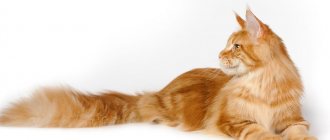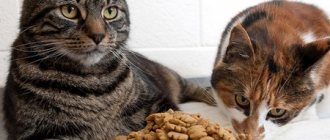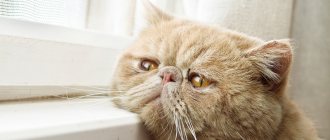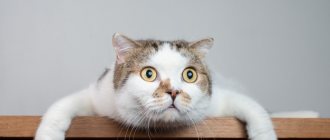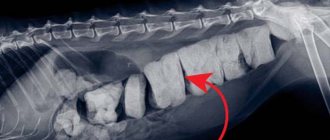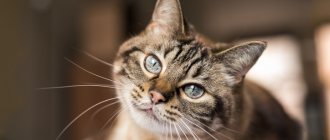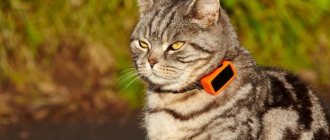5049Pavel
Alkaline phosphatase enzyme activity occurs mostly in the liver, but also in the intestines and to a small extent in bone tissue. In a healthy animal, the total ALP activity in the blood consists of bone and liver isoenzymes. The second reason for increased levels of alkaline phosphatase in the blood of animals is cholestasis or cholangitis. This is a disease in which the secretion of bile slows down and the production of the enzyme increases. Diagnosis of this pathology is problematic, since alkaline phosphatase is present in the blood of cats for only a few hours and then disintegrates. Therefore, veterinarians do not consider ALP as a marker of cholestatic disease.
The second subtype of hepatic isoenzyme rises as a result of the cat taking corticosteroid substances during drug therapy. Another reason is the presence of hyperadrenocorticosis.
© shutterstock
The isoenzyme that is responsible for the activity of alkaline phosphatase in the intestinal tract is located in the thin section. Little research has been carried out in this direction, therefore, when the level of alkaline phosphatase in the intestines changes, they speak with caution about gastrointestinal diseases, and additional research is being carried out.
Increased phosphoric acid metabolism in a cat may indicate hyperthyroidism. This is a hormonal disease that causes an increase in thyroid function. Other liver enzymes are tested to make a diagnosis.
Alkaline phosphatase is elevated in liver diseases, including cirrhosis, necrosis of liver tissue, cancer, infectious and toxic hepatitis, drug-induced hepatitis, and tuberculosis. The activity of the enzyme increases with infarction of the kidneys and lungs, Cushing's syndrome, taking antibiotics, vitamin C, sulfonamide, and bacterial gastrointestinal infections.
In cats, ALP is active in the third trimester of pregnancy, when the fetus and placenta are actively growing. This is a physiological change in the enzyme that does not require treatment.
Causes of eclampsia in cats
The essence of the disease is a negative calcium balance, which occurs as a result of an increased need and insufficient intake of this element into the body.
At the moment, there are more than 30 theories of the occurrence of eclampsia, each recognizing the leading role of calcium, but what exactly triggers this mechanism can only be assumed.
Calcium in the body is found mainly in bone tissue and extracellular fluid.
Bone tissue is a “depot” for calcium, phosphorus, magnesium, sodium and potassium. Calcium in bones is present in combination with phosphorus, carbon dioxide salt, and salts of organic acids in the form of strong crystalline compounds around bone cells. The bone is constantly under stress, so normally the cells here undergo destruction and repair, and calcium levels can change.
Extracellular fluid, in particular blood serum, contains up to 50% calcium in free form, and the rest is combined with proteins and organic substances. The concentration of calcium in the blood is strictly regulated.
Quantitative indicators of calcium compounds in bone tissue are in balance with calcium and phosphorus ions in the blood.
In general, maintaining calcium levels in the body is a complex mechanism. It consists of the processes of absorption and release of calcium, and is mainly regulated by hormones. The nature of the feed, the level of metabolism and, partly, the biological rhythm of the body have an unconditional influence.
The level of calcium in the body is directly affected by:
- Parathyroid hormone, which is produced by the parathyroid glands. It affects the increased release of calcium from the bones, reduces the excretion of calcium in the urine and stimulates the absorption of calcium and phosphorus in the intestine.
- Calcitonin is a thyroid hormone. It is released when calcium in the blood increases and inhibits the effect of parathyroid hormone on bone tissue. In addition, it affects the excretion of potassium, sodium and phosphorus from the body.
- Vitamin D. It is involved in the production of special proteins necessary for the absorption of calcium in the intestines and its excretion through the kidneys. Vitamin D is essential for the normal process of bone growth, which is why its use promotes the effect of parathyroid hormone on bone tissue.
Thus, the process of regulating calcium levels in the body is as follows: with a decrease in the concentration of calcium ions in the blood, the release of parathyroid hormone increases, which increases the dissolution of minerals in the bones. In parallel, parathyroid hormone promotes the formation of vitamin D derivatives in the kidneys, which affects the absorption (reabsorption) of calcium in them. As a result, the concentration of calcium in the blood increases. If necessary, calcitonin can reduce this level.
Changing the amount of calcium is dangerous for the cat's body. For example, an increase in extracellular calcium leads to the deposition of its crystals in tissues, and in the kidneys - in the form of stones. If the process is prolonged, the formation of bone tissue is disrupted. With a short-term decrease in extracellular calcium, a disruption in the transmission of nerve impulses between the nervous system and muscle occurs.
To understand the nature of eclampsia in cats, you need to know a few more important data.
Calcium is one of the most important elements for the body; it is involved in:
- formation of bones, teeth
- blood clotting
- work of neuromuscular excitability
- contraction of skeletal muscles
- functioning of the cardiovascular system
- maintaining vascular tone
- enzymatic processes.
It is this multifunctionality of calcium that determines the various signs of eclampsia in cats.
Calcium is in maximum demand at the end of pregnancy, when inorganic substances accumulate in the bones of the fetal skeleton, and during lactation. This explains the time of manifestation of the disease - the end of pregnancy and the first 4 weeks of breastfeeding.
Natural nutrition for kidney failure
Typically, veterinarians prescribe the following diet for cats with CPZ:
- reduce the level of protein, phosphorus, sodium,
- increase levels of omega-3 fatty acids,
- give B vitamins and antioxidants.
There are different ways to lower your protein levels. You can't just eliminate protein from a cat's diet. It is better to feed them foods containing high-quality protein that is easily digestible. This protein will not harm the cat’s body. Protein that is suitable for cats is found in rabbit, hare and poultry meat.
Vegetable protein is poorly absorbed in the body of cats. Therefore, you should not feed them food that contains chicken, fish or corn meal. Dry food and many canned foods are made from flour.
Eating raw meat does not lead to an excess of protein in the cat's body. This is the natural diet of carnivores. No studies have shown that strictly limiting protein in cats' diets prevents complications from kidney disease.
Doctors usually advise reducing the amount of protein, phosphorus and salt consumed. New research shows that it is more important to reduce the concentration of phosphorus in the blood of sick animals. This is explained by the fact that cats are obligate carnivores and have a naturally high need for protein. It is recommended to supplement the diet of cats with unhealthy kidneys with potassium, B vitamins and omega-3 fatty acids.
A natural diet is great for cats with kidney failure. Game meat is highly digestible, contains the right type of protein and many natural essential fatty acids. Organ meats maintain levels of B vitamins. Raw meaty bones contain less phosphate than grain-based foods.
All these components are contained in natural food SUPERPET. Therefore, the food is suitable for both healthy cats and animals with kidney disease.
A raw meat diet is ideal for any cat because it meets the natural requirements of a true carnivore. Most cats that eat dry food are chronically dehydrated. Therefore, older animals are prone to kidney failure. For such animals, switching to a natural diet that contains the right type of protein and sufficient fluid can be a real salvation.
Did you like the article? Share with your friends:
Symptoms of eclampsia in cats
Animals of different breeds and ages are susceptible to the disease.
Risk group:
- first birth
- eclampsia during a previous birth
- multiple pregnancy
- age animal
- calcium imbalanced diet
- using a drug that lowers calcium levels in the blood.
Symptoms of the disease in cats:
- General condition: depression, fever, rapid breathing and cardiac arrhythmia. The mucous membranes and conjunctiva are pale. There is drooling and refusal to feed.
- Behavioral disorder: the animal rubs its muzzle with its paw, a state of anxiety turns into excitement or vice versa, inhibition. The cat begins to bite the kittens, drag them from one place to another, or leaves the offspring. The animal ceases to recognize its owner. In severe cases, loss of consciousness occurs.
- The appearance of cramps - sudden painful and involuntary muscle contractions. They can begin with a slight twitching of the muscles on the face and paws, and in severe cases they become prolonged. The animal takes unnatural positions, and numbness in certain parts of the body may occur. In extreme cases, the animal falls on its side, movements become constrained or, conversely, abrupt. Loss of coordination occurs.
Instructions for use
“Calcium gluconate” is prescribed by a veterinarian, given orally, intramuscularly, intravenously. Injections are usually used when the amount of microelement in the blood is too low, as well as during childbirth. In other cases, tablets are prescribed. The oral dosage for a cat is 20 mg 2-3 times a day. Injections are administered from 1 to 5 ml. The dose is calculated depending on the age and weight of the animal.
A baby can eat no more than 4 tablets of calcium citrate per day.
“Calcium Citrate” does not contain phosphorus and is available in tablets and powder. Suitable for young growing organisms, small breeds, old pets. Produced by a pharmaceutical company. There is both a separate calcium preparation and a complex with cholecalciferol. You need to give your kitten vitamins 3-4 tablets a day. In powder form, the drug is added to the feed in a dose of ½-1 teaspoon 3 times a day.
“Calcid” contains not only calcium, but also vitamins and microelements. Suitable for people and animals. The dosage is prescribed by the doctor. Usually 1 tablet 1-3 times a day 30 minutes before feeding, depending on age. This dietary supplement is produced in Russia. 8 in 1 Excel Calcium is produced in Germany and contains a full range of all necessary microelements and vitamins. Can be given to cats and dogs. According to the instructions for use, kittens and adult animals should be given ½-1 tablet once a day.
Diagnosis of eclampsia in cats
Due to the various clinical signs of the disease, only a veterinary specialist can establish a diagnosis; he will suggest approximately the following algorithm:
- collecting information about life history, pregnancy, childbirth and the postpartum period;
- clinical examination of the animal: here it is necessary to exclude epilepsy, brain and spinal cord injuries, cerebral vascular pathology and other neurological diseases;
- biochemical blood test to determine calcium concentration. Normally, this indicator in a cat is: - total calcium (or bound) - 8.0-11.5 mg/dl (2.00-2.88 mmol/g); - free calcium -4.5-5.5 mg/dl (1.13-1.38 mmol/l).
A total calcium value of less than 7 mg/dL may result in seizures.
A slight decrease in the concentration of calcium in the blood is usually asymptomatic in a cat.
Eclampsia in a cat may be accompanied by a decrease in blood sugar levels, which is also determined by a biochemical blood test.
Treatment of eclampsia in cats
Emergency treatment of eclampsia in cats! Essentially, the body finds itself in a vicious circle: calcium is needed, but it is not in reserves. The animal develops a serious condition, there is no appetite, so calcium is not supplied with food. The only way out is to administer medications containing calcium. If assistance is not provided, the death of the animal can occur 12 hours after the first attack from heart failure. But with early treatment, the prognosis is favorable.
Treatment can only be prescribed and carried out by a veterinary specialist, approximately according to the following scheme:
- If signs of the disease appear in late pregnancy, a cesarean section is indicated.
- Immediate administration of drugs containing calcium and monitoring of heart function are mandatory. Subsequently, these drugs are used for 7-10 days, and additional therapy is prescribed based on the patient’s condition.
- If the disease manifests itself in a nursing cat, then the kittens are isolated, at least for a day, and are given artificial feeding. The cat itself is placed in a dark room with a calm environment.
In order not to put the animal at risk, it is necessary to carefully monitor the general condition. If the first signs of eclampsia appear, consult a doctor immediately.
First aid and further treatment
The disease requires the fastest possible response, since the animal finds itself in a vicious circle from which it cannot get out.
The fact is that when there is a lack of calcium, food refusal occurs, but the only way to get this substance is to eat a product that is rich in calcium. It turns out that the animal cannot help itself in any way, and the only way to deliver calcium to the body is to inject it with a syringe.
A sick cat urgently needs to be injected with a sedative, as well as a calcium-containing drug heated to the animal’s body temperature. In the absence of first aid, the animal may die within 12 hours after the first attack, so you should not hesitate to call a veterinarian.
Treatment of eclampsia in cats is carried out according to the following scheme:
- If calcium deficiency occurs before birth, then a caesarean section is prescribed to alleviate the animal's condition.
- Prescription of therapy, which is based on the administration of calcium in the required form. All this must be done as soon as possible. The cat's condition is monitored by a specialist, and heart function is also monitored.
- If the disease manifests itself while the kittens are feeding, then the kittens are removed from the cat for a day and fed artificial food. The animal is placed in a darkened room. If the condition does not improve, then therapy is carried out, and the kittens are left on artificial nutrition.
It is important to remember that any drugs that are injected into a cat should be prescribed exclusively by a veterinarian - this is not the case when you can give some pills and forget about the problem.
The disease cannot be cured without the intervention of a doctor, through your own efforts, so do not even try to inject medications yourself, as you can kill the animal.
Prevention of eclampsia in cats
- A responsible owner must know the health status of his cat, therefore, together with a veterinary specialist, it is necessary to prepare the animal for pregnancy (clinical examination, laboratory diagnostics, etc.).
- Monitoring the diet based on the content of calcium, phosphorus, and minerals.
If the cat has previously been exposed to the disease, then the following is necessary:
- monitoring the animal during the entire period of bearing and feeding kittens by a veterinarian;
- long breaks between births.
Feline eclampsia is a dangerous disease that requires immediate treatment and further prevention throughout the animal’s life.
